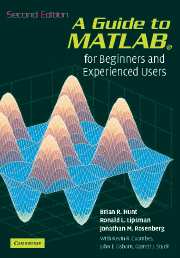Book contents
- Frontmatter
- Contents
- Preface
- 1 Getting Started
- 2 MATLAB Basics
- 3 Interacting with MATLAB
- Practice Set A: Algebra and Arithmetic
- 4 Beyond the Basics
- 5 MATLAB Graphics
- Practice Set B: Calculus, Graphics, and Linear Algebra
- Practice Set C: Developing Your MATLAB Skills
- Solutions to the Practice Sets
- Glossary
- Index
5 - MATLAB Graphics
Published online by Cambridge University Press: 05 September 2012
- Frontmatter
- Contents
- Preface
- 1 Getting Started
- 2 MATLAB Basics
- 3 Interacting with MATLAB
- Practice Set A: Algebra and Arithmetic
- 4 Beyond the Basics
- 5 MATLAB Graphics
- Practice Set B: Calculus, Graphics, and Linear Algebra
- Practice Set C: Developing Your MATLAB Skills
- Solutions to the Practice Sets
- Glossary
- Index
Summary
In this chapter we describe more of MATLAB's graphics commands and the most common ways of manipulating and customizing graphics. For an overview of commands, type help graphics (for general graphics commands), help graph2d (for two-dimensional graphics commands), help graph3d (for three-dimensional graphics commands), and help specgraph (for specialized graphing commands).
We have already discussed the commands plot and ezplot in Chapter 2. We will begin this chapter by discussing more uses of these commands, as well as some of the other most commonly used plotting commands. Then we will discuss methods for customizing and manipulating graphics. Finally, we will introduce some commands and techniques for creating and modifying images and sounds.
✓ For most types of graphs we describe below, there is a command like plot that draws the graph from numerical data, and a command like ezplot that graphs functions specified by string or symbolic input. The latter commands may be easier to use at first, but are more limited in their capabilities and less amenable to customization. Thus, we emphasize the commands that plot data, which are likely to be more useful to you in the long run.
Two-Dimensional Plots
Often one wants to draw a curve in the x-y plane, but with y not given explicitly as a function of x. There are two main techniques for plotting such curves: parametric plotting and contour or implicit plotting.
- Type
- Chapter
- Information
- A Guide to MATLABFor Beginners and Experienced Users, pp. 59 - 78Publisher: Cambridge University PressPrint publication year: 2006

